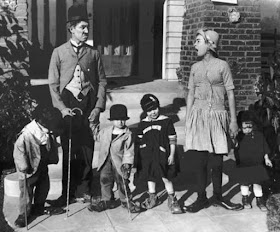It’s been said confession is good for the soul. So here’s mine: I purchased a Kindle edition of my Facebook amigo Steve Massa’s Lame Brains & Lunatics: The Good, the Bad, and the Forgotten of Silent Comedy on August 9, 2013—if what Amazon.com says is true, and I have no reason to believe they would ever lie to me…he said, rather unconvincingly. As you can see by the date of this blog post, it’s been three years since I’ve gotten around to devouring its contents. So I’ll state up front: this is no reflection on Steve’s indispensable reference book. I’m just lazy.
Not that I’m unfamiliar with Steve’s exemplary silent film
comedy scholarship. He’s one the very
best, and if you’ve been thinking about investing in any of the Accidentally
Preserved DVDs (collections of previously thought one- and two-reel
comedies) from Ben Model’s Undercrank Productions, you’ll want to pony up the
additional scratch (only $5.95—a mere bag of shells, as The Great One would
say) for the
companion guide, also co-written by Massa.
He put together a
similar guide for The
Mishaps of Musty Suffer DVDs, too.
(Some of the material in Lame
Brains & Lunatics overlaps with the information provided in these
guides, but that’s certainly understandable.)
Let me approach this from the viewpoint of someone who’s
just been introduced to the wonders of silent movie comedy. Steve’s Lame
Brains & Lunatics goes beyond the parameters of what film historian and friend of TDOY Richard
M. Roberts (and others) often calls “the big three”: Chaplin, Keaton, and
Lloyd. There were a number of unsung
clowns who diligently worked hard to make audiences laugh in the silent era,
and for various reasons (chiefly the inconvenient truth that a lot of their
work has been lost to time and neglect) they’re not well remembered today. You can make a strong argument that some of
them are well-deserving of their obscurity (that’s whom Steve refers to with
the “Bad” in the book’s sub-title) but too many of them were talented
practitioners in the art of mirthmaking, and Massa has made it his mission to
chronicle their careers in a respectful fashion.
Funny ladies also receive prominent chapters in Lame Brains: Alice Howell, Gale Henry,
Fay Tincher, etc. (which reminds me: Steve's next book will be Slapstick Divas...and it will be due out soon, so keep an eye out for it)—I’ve a passing familiarity with their work since a few of
their shorts are spotlighted on the out-of-print Image Entertainment DVD set Slapstick
Encyclopedia (released in 2002).
I particularly enjoyed reading a chapter on Marie Dressler, since I had
the foresight to DVR a few of her features before Rancho Yesteryear’s DISH
austerity program kicked in (I loved Marie in Reducing…Polly Moran—not so much).
In addition, the careers of Roscoe Arbuckle and his nephew Al St.
“Fuzzy” John are examined…not to mention Max Linder, Marcel Perez (the
subject of another book by Massa, and a companion guide to Undercrank’s The
Marcel Perez Collection), and George Rowe. The title of a section on one of my favorites
here at TDOY, Charley Chase, reads
“Comedy’s Best-Kept Secret” (so appropriate) …and you’ll not only learn about
Our Gang but the myriad of kiddie imitators that attempted to duplicate the
troupe’s success.
You know the old cliché about someone “knowing their onions.” That describes Steve Massa to a “T”; Lame Brains & Lunatics is
meticulously researched and sourced (a list of reference works is provided at the conclusion of the book), and Massa’s knowledge of his subject is
nothing short of amazing. I chortled out
loud when I read a line attributed to Steve by one of his friends: “You’re more
interested in the peel than the fruit.”
This is not necessarily a bad
thing. (I also enjoyed how he described the
mantra to his childhood as being “movies, monsters, and comic books.” That sounds awfully familiar.)
Film historian/archivist Eileen Bowser contributes a foreword to Lame Brains &
Lunatics (as a one-time curator for the Museum of Modern Art, she tells a
wonderful anecdote about the first she encountered Steve), while Sam Gill—co-author
with Kalton C. Lahue of the seminal silent film comedy reference book Clown Princes and Court Jesters—has the
final say. In between, however, is the
sensational work of Steve Massa; this book is essential reading for the silent
comedy fan. I only regret it took me so
long to find out.






Sounds AMAZING!
ReplyDelete